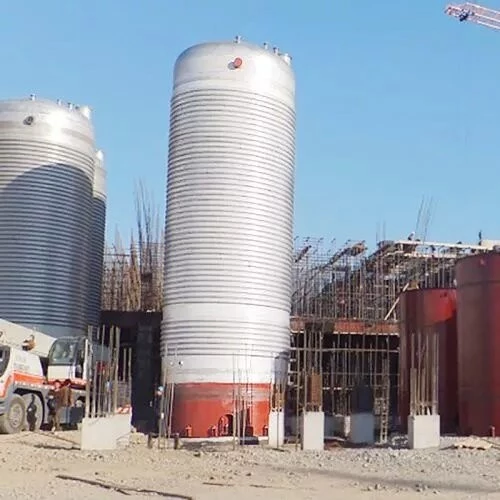Unveiling Categories and Challenges of Stainless Steel for Pressure Vessel

The term "stainless steel" encompasses a fascinating realm of metallurgy, where the addition of a specific quantity of chromium transforms steel into a passivated state, rendering it impervious to rust. The alchemy of achieving this feat involves ensuring that the chromium content surpasses the pivotal threshold of 12%.
Beyond this foundational chromium infusion, the enhancement of steel passivation often involves a symphony of alloying elements, with nickel and molybdenum taking center stage. This orchestration results in stainless steel, a collective term that not only denotes the conventional stainless steel we commonly encounter but also extends to the realm of acid-resistant steel, characterized by its commendable anti-corrosive properties.
In delving deeper into the intricacies of stainless steel, a nuanced classification system emerges, dictated by the structural makeup of the steel. This taxonomy introduces us to four distinct categories: austenitic, ferritic, martensitic, and the hybrid austenitic-ferritic stainless steel.
Austenitic Stainless Steel: Versatility and Challenges
Austenitic stainless steel, celebrated for its versatility and extensively employed in pressure vessels, boasts subcategories such as Cr18-Ni8, Cr25-Ni20, and Cr25-Ni35. Yet, this versatility comes with its own set of challenges, each demanding meticulous attention:
1. Welding Thermal Cracks
The inherent characteristics of austenitic steel, with a small thermal expansion coefficient and a large linear expansion coefficient, pose challenges during welding.
A strategic approach involves reducing impurity elements prone to low-melting eutectic formation, coupled with ensuring a judicious ferritic content within the chromium-nickel austenitic stainless steel.
2. Intergranular Corrosion
The specter of intergranular corrosion looms, attributed to chromium carbide precipitation along intercrystalline boundaries.
Mitigation involves the meticulous selection of ultra-low carbon welding materials, enriched with stabilizing elements like antimony and titanium.
3. Stress Corrosion Cracking
Stress corrosion cracking, a manifestation of brittle failure, necessitates a multi-faceted defense against welding residual stress, structural changes, and localized corrosive media.
4. Sigma Phase Embrittlement of Welded Joints
The intricate dance between the gamma and delta phases and the potential for sigma phase transition demand a delicate balance, especially in chrome-nickel-molybdenum-type stainless steels.
The inherent characteristics of austenitic steel, with a small thermal expansion coefficient and a large linear expansion coefficient, pose challenges during welding.
A strategic approach involves reducing impurity elements prone to low-melting eutectic formation, coupled with ensuring a judicious ferritic content within the chromium-nickel austenitic stainless steel.
2. Intergranular Corrosion
The specter of intergranular corrosion looms, attributed to chromium carbide precipitation along intercrystalline boundaries.
Mitigation involves the meticulous selection of ultra-low carbon welding materials, enriched with stabilizing elements like antimony and titanium.
3. Stress Corrosion Cracking
Stress corrosion cracking, a manifestation of brittle failure, necessitates a multi-faceted defense against welding residual stress, structural changes, and localized corrosive media.
4. Sigma Phase Embrittlement of Welded Joints
The intricate dance between the gamma and delta phases and the potential for sigma phase transition demand a delicate balance, especially in chrome-nickel-molybdenum-type stainless steels.
Ferritic Stainless Steel: for Enhanced Corrosion Resistance
Ferritic stainless steel, with its bifurcation into normal and ultra-pure variants, presents an intriguing challenge due to its high carbon and nitrogen content:
1. Grain Growth and Intergranular Corrosion
High-temperature welding prompts rapid grain growth, particularly in the vicinity of the weld, elevating the risk of intergranular corrosion.
2. Post-Weld Embrittlement
The inherent characteristics of ferritic steel amplify the severity of post-weld embrittlement, necessitating a nuanced approach to welding procedures.
3. Temperature-Induced Changes
A slow dance between temperatures and steel characteristics can result in embrittlement, with specific temperature ranges triggering distinctive phases and transformations.
High-temperature welding prompts rapid grain growth, particularly in the vicinity of the weld, elevating the risk of intergranular corrosion.
2. Post-Weld Embrittlement
The inherent characteristics of ferritic steel amplify the severity of post-weld embrittlement, necessitating a nuanced approach to welding procedures.
3. Temperature-Induced Changes
A slow dance between temperatures and steel characteristics can result in embrittlement, with specific temperature ranges triggering distinctive phases and transformations.
Martensitic Stainless Steel: A Symphony of Corrosion Resistance
Martensitic stainless steel, with its subcategories including Cr13, low carbon, and super martensitic, introduces a diverse palette of corrosion resistance:
1. Tendency to Harden
The welding journey with Cr13 martensitic stainless steel involves a strong inclination towards hardening, culminating in the formation of hard and brittle martensite.
2. Cold Cracks and Coarse Ferrite Formation
Air-cooling conditions set the stage for cold cracks, while controlled cooling rates dictate the formation of coarse ferrite and carbides, impacting the plasticity and toughness of the welded joint.
The welding journey with Cr13 martensitic stainless steel involves a strong inclination towards hardening, culminating in the formation of hard and brittle martensite.
2. Cold Cracks and Coarse Ferrite Formation
Air-cooling conditions set the stage for cold cracks, while controlled cooling rates dictate the formation of coarse ferrite and carbides, impacting the plasticity and toughness of the welded joint.
In the realm of low carbon and super martensitic stainless steel, a contrasting narrative unfolds, where welding performance is commendable without the overt hardening observed in other counterparts. In the grand tapestry of stainless steel, each category unravels a tale of metallurgical intricacies and welding considerations, enriching our understanding of this enduring material.

